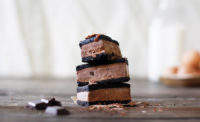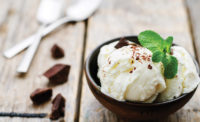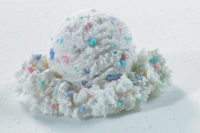Consumers still love eating ice cream and other frozen and refrigerated desserts, but now many are looking for cleaner versions of their favorite treats. Alongside this, even those who desire to eat healthfully still don’t want to give up the indulgence factor.
Even many of America’s healthiest eaters give into indulgences based on their emotional states, according to Foodmix Marketing Communications, Elmhurst, Ill., a full-service food branding agency. A study by Foodmix revealed that 40% of U.S. food-brand lovers who rated their daily diet as extremely healthy agreed with the statement, “When I’m feeling down, I eat something indulgent to make me feel better.”
Despite the fact that many Americans are trying to eat more healthfully, the findings show that America’s love affair with indulgent foods has reached even the most disciplined group of eaters, Foodmix said.
“It’s likely that members of this group need to give themselves ‘permission’ to indulge and may, in fact, turn indulgence food into a sort of self-care,” Foodmix said.
Nearly all consumers purchase frozen treats, especially ice cream, yet growing purchase and consumption frequency often presents challenges for indulgent categories, said Chicago-based Mintel in its April 2018 “Ice Cream and Frozen Novelties — U.S.” report. Frozen treats with hints of wholesome ingredients and healthy notes conveyed through product claims and real ingredients may allow consumers to more frequently consume them with less guilt, Mintel said.
Alexandra Chamberlain, managing director, Pots & Co., USA, San Francisco, said consumers still want to indulge, but they also want to know their treats don’t contain things such as preservatives, artificial colors or flavors, palm oil and corn syrup.
“Instead, they want only the best, simple ingredients that they would find in their cupboard at home,” Chamberlain said.
Cold dairy desserts by the numbers
U.S. demand for ice cream and frozen desserts is forecast to total 7.6 billion pounds in 2022, according to “Ice Cream & Frozen Desserts: United States,” a June 2018 report from The Freedonia Group, Cleveland. Advances will continue to reflect strong marketing efforts and new product introductions over the forecast period, according to the report.
These new product introductions will need to address consumers’ desire for healthier, yet still indulgent desserts.
“A growing preference for natural, less processed and convenient food has reshaped the frozen category as consumers moved from shopping center-store aisles, including frozen desserts, and moved to shop the store’s perimeter, said Rebecca Leinenbach, vice president of marketing/communications for Prairie Farms Dairy Inc., Edwardsville, Ill. “The good news is that volume growth for the frozen food category turned positive for the first time in five years during Q1 2018.”
While sales within the frozen desserts category have been declining, ice cream and novelty sales have fared better than the frozen category overall, Leinenbach said.
Indeed, according to data from Chicago-based market research firm IRI, the ice cream/sherbet category saw dollar sales increase 2.2% to $6.9 billion and unit sales climb 1.6% to 1.8 billion during the 52 weeks ending April 22, 2018. Compare this to the frozen desserts and topping category, which saw dollar sales drop 2.0% to $678.3 million and unit sales fall 4.5% to 259.8 million during the 52 weeks ending June 17, 2018.
Things look a little more promising for the refrigerated dessert side. The refrigerated desserts category, made up of refrigerated pudding, mousse, gelatin and parfaits, saw dollar sales increase 1.4% to $729.9 million during the 52 weeks ending June 17, 2018. Unit sales improved even more, up 4.8% to 377.5 million. Faring even better, the cheesecakes category enjoyed a 6.7% dollar sales increase to $306.7 million. And unit sales jumped 16.9% to 51.1 million.
Trends and growth drivers
Chamberlain said that the biggest trends affecting both refrigerated and frozen desserts are clean ingredients, good sourcing, ethical manufacturing processes, sustainability and social responsibility.
In truth, these are trends that are affecting almost all food categories.
Chamberlain also noted that consumers’ desire for vegan, gluten-free and dairy-free dessert products is also increasing.
Premiumization is another aspect that’s helping grow sales in the category, Chamberlain added.
“[For example], luxury brands with exceptional quality [ingredients] are winning with shoppers,” she said.
Single-serve is another trend that continues to be huge with consumers, Chamberlain said. Drivers include convenience and portion control.
“Consumers look to pick and choose based on individual and personal preference,” she explained. “Reducing plastic and ensuring reusability and recycling of packaging is [also] a huge trend, which will get bigger.”
When it comes to flavor trends, Chamberlain said her company is seeing twists on classic chocolate recipes such as salted caramel and single-origin chocolate.
Patrick Galleher, CEO of SweetFrog, Richmond, Va., said his company is seeing “more flavors that utilize multiple recipes mixed together to create fun engaging flavors.”
And Phil Hipsky, director of product development for SweetFrog, noted the strong emphasis on authentic flavors this year. He said SweetFrog added several different flavors to its frozen yogurt line this year, including chocolate-covered strawberry, Purple Berry Bom (raspberry cotton candy), homemade peanut butter cookie and Peach Melba.
“We’re also seeing more brands work harder to differentiate their core line of products,” Hipsky added.
Clean ingredients dominate
“Keeping up with the clean-label movement means more than [just] simplifying ingredient lists. It’s also about sustainability, food safety, ethical production and transparent business practices,” Leinenbach said.
She explained that Prairie Farms’ farm-to-table story, along with a behind-the-scenes look at its farm families and information about its quality and food safety standards, is available to consumers on its website.
Chamberlain said clean labeling is a huge move in the right direction, but it can cause confusion for some consumers.
“The breakdown of scientific ingredients in flours and baking products, for example, can make a ‘clean’ product look overly complex and modified, when in fact it’s not. It takes an educated consumer to distinguish between what’s OK [and what’s] an unnecessary preservative or additive,” she said.
Chamberlain added that on-trend clean ingredients in desserts include free-range eggs and non-GMO and handmade ingredients. She also noted that “provenance is a growing trend, too,” as consumers are more educated and interested in where their food comes from.
Nathan Carey, founder and president of Swell Foods, Santa Barbara, Calif., said that consumers who purchase better-for-you ice creams and desserts say taste is most important, followed by a desire for fewer, cleaner ingredients, higher levels of protein and lower levels of fat, calories and sugar.
It was the success of high-protein and reduced-sugar ice cream brands such as Los Angeles-based Halo Top and the findings above that motivated Swell Foods to rebrand its ProYo ice cream brand to Swell Ice Cream, a new line available in stores this year. Swell Ice Cream is made with non-GMO ingredients and nothing artificial. The vanilla flavor contains 120 calories, 1.5 grams of fat, 9 grams of sugar, 7 grams of sugar alcohol and 10 grams of protein per 1/2-cup serving. As part of the rebrand, the company introduced two new flavors: chocolate chip cookie batter and cookies ‘n cream.
Convenience and portability
Dessert products that offer convenience and are available in single-serve options also are winning with consumers.
“Clean-label, fresh, convenient snack foods is a category that is thriving in the refrigerated and frozen food category,” Leinenbach said.
Last year Prairie Farms introduced Milk Snack bars, refrigerated two-layer crème-filled chocolate cake bars dipped in chocolate. Unlike most conventional shelf-stable chocolate snack cakes, the bars have a short, simple ingredient list and do not contain artificial colors or preservatives, according to the company. The bars are also made with real milk. They are sold as single bars or in four-count packages and are designed to be a portable, convenient snack or dessert. The snack bars topped Dairy Foods’ Best New Dairy Products awards in 2017.
Sweetaly Dolceria, Oceanside, Calif., makes refrigerated European-style desserts such as mousse and tiramisu that are packaged in 3-ounce reusable glass jars. The company uses only all-natural ingredients, and its desserts have a nine-month frozen shelf-life and can last up to 30 days refrigerated.
This year, the company launched its American Favorites cheesecake line (in strawberry, lemon and plain varieties) made with what it calls an “Italian Twist.” The company replaced part of the heavy cream cheese with ricotta cheese, giving it a creamier taste and unique texture, said Guto Antunes, sales manager for Sweetaly Dolceria.
San Francisco-based Petit Pot produces a line of French-inspired gourmet puddings that are also packaged in 4-ounce glass jars. The company uses simple, high-quality ingredients and touts its sustainable packaging. The puddings are available in six varieties, including dark chocolate, salted caramel and lemon curd. They’re made with organic milk and cream, as well as organic cane sugar. The company also launched a vegan rice pudding this year, keeping up with the trend toward dairy-free dessert options.
For its part, United Kingdom-based Pots & Co. added a chocolate and salted caramel variety to its line of lava cakes. The new flavor will be available in the United States soon, the company said. The individual-size dessert features chocolate cake with a salted caramel center and is packaged in a 4.4-ounce ceramic pot. The company said its desserts are always handmade fresh with no preservatives.
Facing challenges
Many of the dessert companies with which Dairy Foods spoke mentioned the challenges that the frozen and refrigerated dessert markets face — the biggest being a crowded marketplace and competition.
“Both the ice cream and novelty categories are highly competitive,” Leinenbach noted. “Adding to the challenges of competing in the crowded categories is the push by retail outlets away from national and regional brands toward private label products.”
Then there’s the difficulty meeting consumers’ desire for healthier, cleaner products, but with a mouthfeel and taste they still enjoy.
Carey said it’s challenging to formulate products with added nutritional value without sacrificing taste, texture or quality of ingredients.
“To reach higher levels of protein per fluid ounce, for example, we had to create a now-patented process to have an ice cream that has a smooth, creamy delicious taste, unlike many high-protein products that have a strange taste or mouthfeel,” he explained.
Looking ahead
Now is the time for frozen and refrigerated dessert companies to innovate.
“Despite shifts toward healthier lifestyles, consumers are still active and interested in the [ice cream and frozen novelties] category, suggesting that indulgence is still in fashion,” Mintel said. “Yet consumers have some fairly strong habits — in consumption frequency and product selection — that require disruption to grow the category. Interest in further innovation suggests that consumers want to break these habits and seek permission to indulge more, yet on their own terms.”
Schwan’s Co. launches Edwards Dessert Kitchen
In July, Marshall, Minn.-based Schwan’s Co. launched its first-ever dining experience, in downtown Minneapolis. Called Edwards Dessert Kitchen, the restaurant is “the ultimate destination for unapologetic indulgence,” the company said.
The menu includes more than just pie, offering modern dishes such as miso caramel pudding, vegan chocolate mousse, coconut crème pie puffs and passion fruit soufflé. Inspired by Schwan’s Co.’s Edwards dessert brand, Edwards Dessert Kitchen offers a unique dessert-forward experience, the company said.
“The restaurant will be an aspirational expression of the company’s retail brand, Edwards, with the menu serving as inspiration for the brand’s future innovation,” said Polly Madsen, manager of culinary initiatives for Schwan’s Co. “Our goal is to challenge people’s perceptions of desserts — catering to different lifestyles and offering better-for-you options.”










